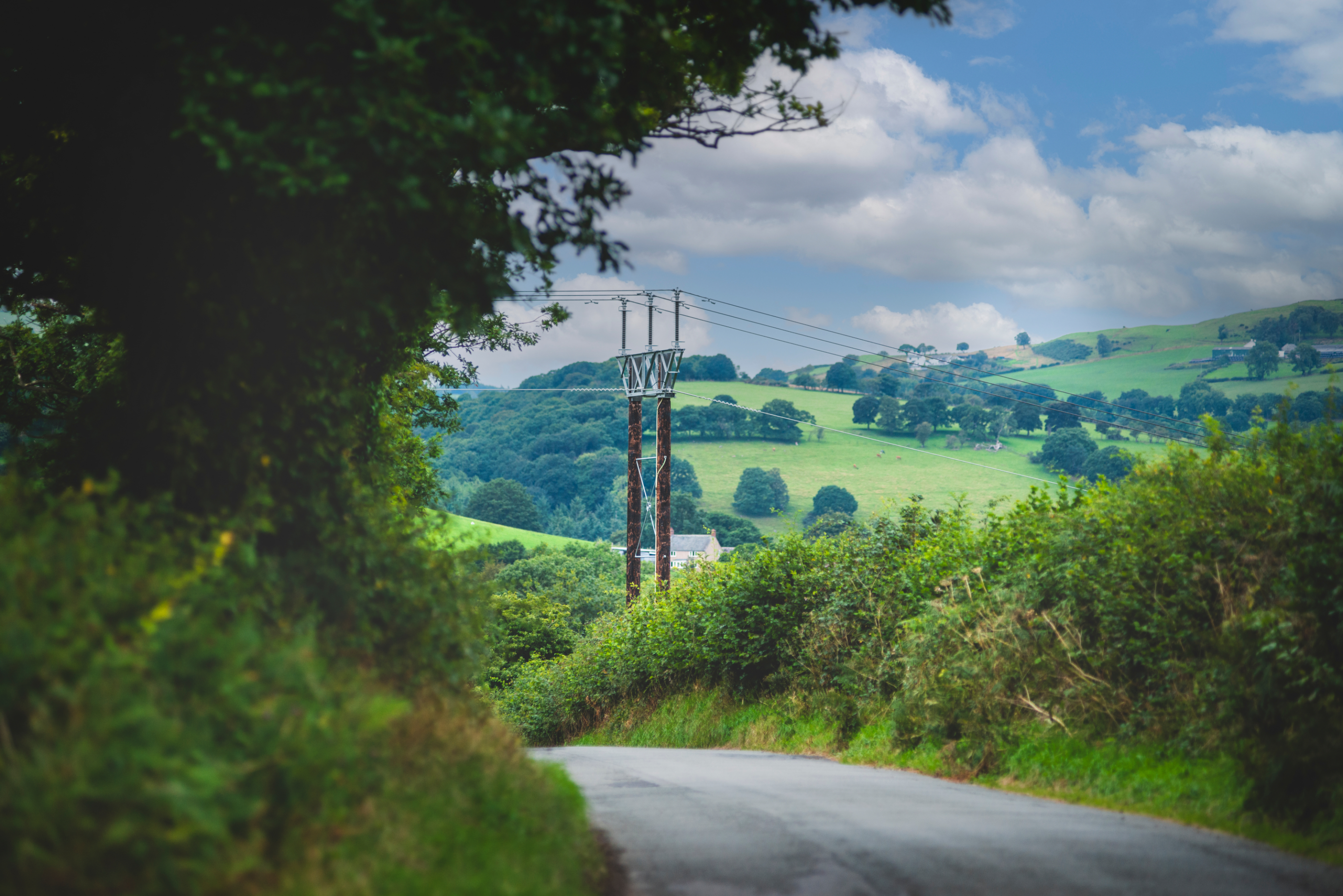Green Generation Energy Networks Cymru (Green GEN Cymru) is proudly based in Wales and is developing green energy networks to meet the future needs of Wales’ people, communities, and businesses.
We have a vision for a healthier, wealthier Wales, that uses clean energy generation as a positive power locally and regionally, to create a more sustainable future for this and future generations.
As an Independent Distribution Network Operator (IDNO), we’ll design, construct and maintain a new 132kV (132,000- volt) electricity distribution network - needed to add capacity to the local grid network, connect new Welsh energy projects to the electricity transmission network, and enable the rollout of electric heating and vehicles helping to get green energy to homes and businesses across Wales and beyond.
Adopting renewable energy sources will have positive impacts on local communities right across the country. Connecting local generation to the National Grid is crucial for improving our energy independence and resilience, reducing our vulnerability to UK energy supply disruptions. Our new network will allow businesses and new energy users to connect in, thereby creating new job opportunities and stimulating economic growth.
We will work closely with Welsh communities and stakeholders as we develop our plans, to maximise the benefits and minimise the impacts for local people. You can find out more at the Green GEN Cymru website www.greengencymru.com.
Rhiwlas Green Energy Network (GEN) is an overhead line connecting from Bute Energy’s Banc Du and Rhiwlas Energy Parks to a collector substation site in the Powys uplands, near Cefn Coch, as well as a new underground cable connection between the two proposed Energy Parks.
The proposed overhead line, supported on wooden poles and with an underground cable section, will connect Bute Energy’s proposed Banc Du and Rhiwlas Energy Parks to a collector substation site in the Powys Uplands near Cefn Coch.
To learn more about Bute Energy’s proposals, visit: www.bancduenergypark.wales and www.rhiwlasenergypark.wales
Section 1
Cefn Coch (Llyn Lort Energy Park) – Carno – Trefeglwys
As the route leaves the Bryngwyn substation location, it previously headed towards the Y Capel Stone Circle and passed through the site of the proposed Esgair Cwmowen Wind Farm. A decision has been taken to avoid the boundary of the wind farm as far as possible, so the revised route now deviates outside of the previous corridor to the east and south to avoid the wind farm and more closely follow the River Rhiw at the base of the Esgair Cwmowen. From there, it rejoins the corridor to the southeast of the stone circle.
There were also some specific change requests relating to the ecological value around the existing Scottish Power Energy Networks (SPEN) 132kV line that heads down to the A470. In response to this request, we have avoided vegetation clearance as far as possible, and sited wood poles In field margins. The route now also hugs the western extent of the corridor between Maesypandy and the A470 at Oerffrwd. This is driven by needing to locate the most practical and least impacting crossing point of the road and mainline railway. It also avoids the more sensitive vegetation to the north of the Scottish Power Energy Networks (SPEN) route and maintains appropriate separation from the SPEN route itself.
Section 2
Trefeglwys – Llanidloes – Llangurig (Rhiwlas Energy Park)
Consultation feedback sought to minimise the impacts on Trefeglwys village and the overall village itself. The route has been revised eastwards from the crossing of the B4569 towards the bottom of the valley and the Afon Cerist.
The route follows the corridor tightly to the east as it heads up past Llyn Ebyr to follow the contours and use the topography of the area to maximum screening effect. There is also a 132kV line within the centre of this corridor and the route has been designed to ensure it is appropriate distance away from that.
Between the foot of the Brynposteg Hill and the A470, the route now deviates slightly outside of the original corridor and is closer to the A470. This was because further environmental studies have identified this area had suffered landslips in the past, which made it highly unsuitable for wood poles. Feedback also suggested the route should follow the hill ward side of the old railway to the east of the River Dulas and some concerns were raised about impacts on properties and businesses here. Due to these two factors, the route has been aligned to cross the River Dulas closer to the A470 and nearer to the disused quarry in a more direct alignment.
Section 3
Rhiwlas Energy Park – Banc Du Energy Park
This section remains largely unchanged and limited feedback was received as part of the previous consultation on the preferred corridor in this area. The proposed underground cable route follows the access track that was established for the construction of the Bryn Blaen Wind Farm, which heads northeast from the A470 near the Rhiwlas substation and following the track up to Bryn Blaen-y-Glyn. It crosses the minor road between Llangurig and Llanidloes in the centre of the preferred corridor, where it continues to follow the access tracks past a few of the Bryn Blaen turbines. The route deviates outside of the preferred corridor to efficiently connect to the Banc Du substation and avoid overlapping with the network of underground cables connecting the Bryn Blaen turbines to their substation. Where the cable route leaves the preferred corridor, it continues to follow the access track before picking up the alignment of a bridleway northward and then south-westerly to the Banc Du substation.
There will be no public funds used. As an Independent Distribution Network Operator (IDNO), Green GEN Cymru will pay for the design, construction and maintenance of the new 132kV (132,000- volt) electricity distribution network - needed to connect new Welsh renewable energy projects to the electricity transmission network, helping to get green energy to homes and businesses across Wales and beyond.
The overhead lines for the Rhiwlas GEN will be supported on wood poles. The poles are typically 12-14m tall. The average distance between the wood poles, or ‘span length’ is approximately 85m.
The exact wood pole heights and span lengths vary depending on the terrain or obstacles they cross, such as streams and rivers. Where the two proposed lines change direction, angle poles will be required, with stay wires for stability.
Given the rural character of the proposed OHL route it is felt that wood poles will blend sympathetically into the landscape, minimising the overall visual effect of the proposals.
An example of what the wooden poles will look like can be seen here:
Examples of what the wooden pole connection will look like - click the image above to open a gallery
The proposed switching station, located near Cefn Coch, Llanfair Caereinion will be similar in appearance to an electrical substation, such as the existing Builth Wells substation pictured shown below.
The proposed switching station will also be a connection point for the Vyrnwy Frankton grid connection project.
The plans for the switching station are being developed and will be included in the DCO application for the Vyrnwy Frankton grid connection project which will launch in spring 2025.
Between November 2023 and January 2024. we consulted local people on our preferred route corridor for the new connection. Since then, we have carefully considered all the feedback we received, alongside further environmental and technical assessments, and we have made several changes to our proposals.
We are now consulting on our draft route alignment, which gives more detail on where the proposed new infrastructure might go, including proposed wood pole positions.
Our second round of consultation runs from Tuesday 5 November to Tuesday 17 December 2024.
Our non-statutory consultation is open from Tuesday 5 November to Tuesday 17 December 2024.
You can view an interactive map and find out more information about this consultation on our website. You can view and download project materials that provide more information about our proposals for the Rhiwlas GEN project in our document library.
Come and see us to view more information and to meet and ask questions of our project team. A computer visualisation of the preferred routes will be available to see at the events.
Community event information can be seen in the timetable below:
| Location | Date | Time |
| Cefn Coch Inn Welshpool, SY21 0AE |
Thursday 14 November | 2pm – 7pm |
| Trefeglwys Memorial Hall Caersws, Powys, SY17 5QX |
Tuesday 19 November | 2pm – 7pm |
| Llangurig Community Centre Llangurig, Llandiloes, SY8 6SG |
Wednesday 20 November | 2pm – 7pm |
Detailed feedback from communities and specialist organisations will help us better understand any potential effects of our proposals and is a key part of how we’ll develop the two projects in response to local needs. There are several ways you can provide your feedback or contact us.




Please submit your feedback to us by 23:59 on Tuesday 17 December 2024.
Any feedback received after this date may not be considered by our team.
All the feedback we receive by the deadline will be reviewed and carefully considered as we develop our plans.
We will use your feedback to review the decisions we've made to date and to inform our work going forwards.
New electricity transmission lines of 132kV are classed as a Development of National Significance (DNS) in Wales. This means developers must apply for planning consent to Planning and Environment Decisions Wales (PEDW) and final decisions are made by the Welsh Ministers.
Feedback from our public consultation and from local authorities, community councils and national organisations will help us develop a final design for the project. We will also carry out further technical assessments and surveys to inform our Environmental Impact Assessment (EIA).
Before we submit a consent application to Planning and Environment Decisions Wales (PEDW), which is expected to be in 2025, there will be a statutory Pre-Application Consultation (PAC) period, where people will be able to review and comment on the detailed designs and the draft Environmental Statement.
Grid connection projects such as the Rhiwlas Green Energy Network must consider a wide variety of issues including things like impact on the environment, engineering constraints, topography and economic viability.
Undergrounding cables often can have a more significant impact on the environment given the invasive nature of construction and costs up to ten times more than the construction of an overhead line.
These factors have been considered in some detail already, however as part of our consultation we are keen to hear people’s thoughts on the work we have done to date, including areas of high sensitivity along the route where mitigation may be required including the use of underground cables.
A key part of preparing our plans is consultation with landowners, stakeholders and the public. We also follow established guidelines for routeing overhead lines, taking account of environmental studies, technical and economic factors.
It’s a complex process, and we must find a balance between the environment, engineering requirements, economic viability and the views of people who live, work, enjoy recreation and pass through the area.
Following the first round of consultation, we have been carefully considering all feedback received, along with further environmental, technical assessments and survey information.
We have now developed a detailed draft route alignment, including proposed wood pole locations, working areas and access routes, which are now subject to further public consultation, with a detailed Environmental Impact Assessment (EIA) still to follow.
We will then carry out a final ‘statutory’ Pre-Application Consultation process which will enable residents, stakeholders and other interested parties to review and comment upon all the draft application documentation prior to the plans being finalised and a planning application being submitted to Planning & Environment Decisions Wales (PEDW).
Overhead lines of 132kV require consent from Welsh Ministers under the Developments of National Significance (Wales) Regulations 2016.
Following our pre-application consultation and completion of the Environmental Impact Assessment (EIA) we will submit a planning application to Planning and Environment Decisions Wales (PEDW) around autumn 2025. Independent planning inspectors will then hold a final round of statutory consultation before making a recommendation to Welsh Ministers on whether or not to grant planning permission for the application.
The Rhiwlas GEN wood pole route will contribute to a more resilient electricity network, ease pressure on the existing local grid, support businesses, and enable the roll out of green heating and electric vehicles in rural communities.
We are in the early stages of development of this project and no final decisions have been made on where the wood poles will be sited.
This is our second stage of consultation, we are asking you for your feedback on the draft route alignment, along with any other factors you would like us to consider when developing our proposals for the project. It is important that people respond to this consultation and tell us their concerns so we can work to reduce the effects on communities and individual properties.
The final route will be informed by a wide variety of feedback from residents, stakeholders and statutory bodies such as PEDW, Natural Resources Wales (NRW), and others, as well as the results of technical surveys and assessments.
Once we have a final design, we will speak to all landowners affected on a one-to-one basis and discuss how we can support them. We will work hard to reduce impacts on individual properties but if the final design does impact your property, we will discuss what options are available to you in line with current legislation. Please contact us if you have a particular concern.
A changing climate is having a dramatic effect on plants and animals – protecting biodiversity is one of the key drivers for moving away from fossil fuels.
Our proposed network has been carefully designed to take into consideration the ornithology, wildlife and habitats along the route.
We will comply with current guidelines in Wales on achieving a net benefit for biodiversity within the area. We will work closely with the relevant stakeholders to deliver an environmental benefit that goes above and beyond these requirements. We are committed to achieving at least 10% net gain in biodiversity compared to today.
By contributing to a more resilient electricity network and easing pressure on the existing local grid, our new Green GEN Cymru network will support businesses, help to create jobs and stimulate economic growth and enable the roll out of green heating and electric vehicles in rural communities.
We are proudly a Welsh company, and we are committed to investing in Wales and supporting the Welsh economy by directly providing opportunities to the Welsh supply chain wherever possible.
Using green energy to power your home or business can help to lower your energy costs – it’s cheaper than gas and nuclear. And importantly, transitioning to low-carbon energy is crucial for the health of the planet – renewable energy sources produce little to no emissions.
Green GEN Cymru will enable low-carbon generation to be connected to the electricity network and to the homes and businesses where we use it. Once up and running, wind generation is one of the cheapest forms of electricity generation and the proposed Rhiwlas GEN will contribute towards controlling our energy prices in the future.
Recent energy price surges have been driven by global events impacting the price of gas. By producing more of our energy in the UK, and achieving energy independence, the country is far less vulnerable to global energy crisis.
In the first stage of consultation, we asked for feedback on the preferred route for Rhiwlas GEN, along with any other factors you would like us to consider when developing our proposals for the two projects.
Since then, we have been speaking with landowners to help us develop the draft route alignment.
It is important that landowners and communities respond to this consultation and tell us their concerns so we can work to reduce the effects on individual land parcels and communities. Once we have refined our proposals further, we will work with all landowners affected to discuss how we can support them. We’ll continue to work hard to reduce impacts on individual land parcels.
If the final design does impact your land, we will discuss what options are available to you in line with current legislation. Please contact us if you have a particular concern.
If the project is consented, construction will begin in 2027, with energy distributed to homes and businesses in Wales by 2028.
High-voltage overhead lines can sometimes generate noise, under certain conditions. This often sounds like either a crackle or humming sound and occurs mainly during wet weather.
Noise may occur from wind blowing past the line or wood poles. Any potential noise impacts will be considered as part of the Environmental Impact Assessment (EIA). We will always ensure that the design of the overhead line considers any impacts on the local community.
Electric Magnetic Fields (EMFs) are produced whenever electricity is used or transmitted. Household wiring, appliances and electricity supply are all sources. So, they are around us all the time in modern life. Overhead lines are a source, but just one of many.
There are limits in place to protect us all against EMF exposure. These limits have been based on careful reviews of the science by independent experts, who recommend safe levels of exposure for the public. The exposure limit for members of the public is 360 microtesla, even if you are standing directly underneath the overhead line, the levels are just a small fraction of the limit. After many decades of research and hundreds of millions of pounds spent investigating the issue, there are no established health effects below the exposure limits. More information is available at www.emfs.info.
We are committed to causing the least disturbance we can to those living and working in the areas affected by our proposals. We will take advice from technical stakeholders and consider the project’s impact on local roads as part of a traffic and transport assessment, which is a requirement of the process we will follow to submit a planning application.
Overhead lines supported on wood poles are relatively straight forward to construct. We will follow established procedures throughout the construction process, carefully working to reduce potential disturbance to local people wherever possible. This will include how we plan to manage construction traffic, including any potential impacts. We recognise the importance of maintaining connectivity between nearby towns and villages and we will ensure that our work does not make it difficult for those living and working in the area.
You can contact the project team and/or provide your feedback via any of the methods outlined below:
- Fill in our online feedback form.
- Email the project team at info@rhiwlasGEN.wales.
- Telephone our freephone information line – 0800 699 0081 (Monday to Friday, 9am-5pm)
- Write to us at FREEPOST TC CONSULTATION (no further address or stamp required)
You can also attend one of our public consultation events, speak to a member of the team and fill out a feedback form in person. More details on these events can be found here.
